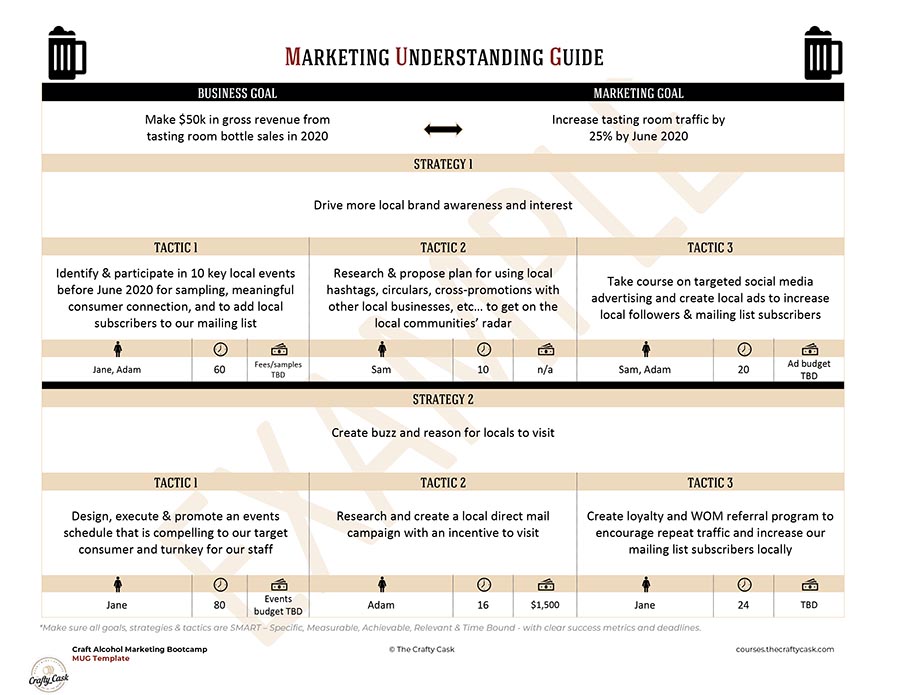Listen, my craft maker friends, let’s get one thing straight: I love marketing. When done right, it can be one of the biggest differentiators between failing and thriving craft distilleries. And my number one priority is ensuring more craft makers land in the thriving camp. Which means, “Yay! Marketing!” But there’s a catch. It’s often way too easy to say yes to marketing ideas and opportunities when they come our way, especially when we’re in the early stages or have big growth targets. We’re like ravenous fans at a football tailgate: We really want a big, juicy T-bone, but wave a flabby cold-cut in front of us and we’ll eat it. No more flabby cold-cuts! T-bone or go home.
Let’s be honest, though. It’s a beautiful thing and feels really good when people reach out or opportunities show up on your doorstep that will help get your brand name out there. I get it — it’s flattering! And likely at least a little beneficial. But we’re all too busy and resource-constrained to spend our time on things that will only move the needle a little bit. We don’t want to play a game of inches; we want to play a game of yards, which means we need a well-thought-out marketing plan.
Marketing that delivers true business value is the only kind of marketing I ever want you to do, but determining the value takes some planning and a commitment to continually refer to that plan whenever new opportunities arise. This practice — developing a clear marketing plan, sticking to it, and intentionally updating it — can be lax for a lot of marketers, which leads to wasted resources and frustration with results. Developing your marketing plan will help you understand all marketing activities and how they connect to your business goals, so you can ensure everything you do in marketing makes sense and is worth your time, money and energy. In fact, once you get this down, it will become your go-to marketing touchstone. Here is an easy-breezy template from our Craft Alcohol Marketing Bootcamp to get you started.
Set Clear, SMART Goals
First things first: You have to be clear on your overarching business goals. And please note: Business goals and marketing goals are not one and the same. Your marketing objectives should ladder up and help you achieve your business objectives, but you also need to have sales, product and financial goals all working together to achieve your overall business objectives. Marketing is just one piece of the puzzle. And each goal — whether business or marketing — needs to be SMART (see sidebar). “Make $200k in revenue” is not SMART. “Make $50k in gross revenue from tasting room bottle sales by November 15, 2020?” Yes! “Increase brand awareness?” Not SMART. “Increase brand awareness by growing our social media following from 2,000 to 5,000 by March 2020?” Better!
For each marketing goal related to a business goal, create a MUG sheet like in Figure 1. Since you often need multiple marketing goals to achieve each business goal, I first brainstorm all the marketing goals related to each business goal before moving them onto these sheets. In this example, before we can focus on driving sales, we need to focus on driving people into the tasting room. Therefore, our first marketing goal to reach our business revenue goal is all about driving tasting room traffic. And then you would have a second marketing goal related to converting that traffic into sales once you have the customers in your tasting room. The key is to keep it simple and SMART. Thinking about the different phases of the consumer journey and what you might need to do in each area to achieve your goal is often helpful.

Start with One Thing
Realistically for any business goal, where do you need to focus your marketing energy? Are you brand spankin’ new and need to drive awareness before you can even dream about moving consumers deeper into their journey with your brand? Or, do you already have good awareness, but now you need consumers engaging with your brand, indicating consideration/evaluation? Or, do you have great big groups of fans who are already aware and considering and have enough of a relationship with you that you can start moving them to visit or buy? Or would your existing fans sharing with others be the most helpful in reaching this business goal?
Now, I know: You’re all going to feel like the answer is, “I need all of those things to be happening!” You’re right, of course. But here’s the trick: If you make your goals SMART goals, it will really help you home in on what work is most important to drive the tangible result you need, right now. Where you have multiple marketing goals per business goal, think a little about the order of operations or any contingencies between them to help prioritize and plan.
Then you can drop down into how you’re actually going to achieve that marketing objective. What specific activities, people, time and resources will it take to get you there? This, friends, is where we circle back to our original goal of figuring out when to say no to marketing. Once you have your plan all pulled together and are clear on what activities it’s going to require to get there, you essentially use this as a vetting document.

Anytime an interesting marketing opportunity pops up, no matter how amazing or exciting it seems, refer back to this document. Figure out where it fits into your current plan or if adding it into your current plan would truly be helpful in achieving any of your marketing strategies, goals or business goals. If it doesn’t fit in but something in your gut tells you that you should do it, force yourself to sit down and review your plan carefully and figure out what resources it will take to do this and if now, given your goals, is really the right time to do it. If you decide it is, update your document to reflect the new reality by adding in a new tactic, strategy or goal related to this opportunity. More often than not, however, you’re going to compare these opportunities against your plan and realize that, as compelling as it may seem, it just isn’t a top priority for you, which empowers you to say no and feel good about it.
I know: this feels like a lot of work. Especially the first time around. But it’s important work. Once you have it completed, think about the clarity and focus your marketing decisions will have. Strategy helps us make smarter decisions, use our resources more effectively and achieve our goals faster. This is how we drive real results from our activities, not just for marketing but across all areas. And ultimately, it will save you time when you can confidently turn down a tasting event that would have taken hours of your time and bottles of your product when it’s not truly in line with your top priorities to grow your business right now.
This should be a living, breathing document. It’s important that you review and update it every six months or so, to record goals you have achieved (yay!), make any adjustments to priorities and revise or add tactics, strategies or goals.
We all want to do everything at once and push forward on all of our goals at once. But it’s detrimental to our long-term goals if we allow ourselves to get distracted every time a new marketing opportunity or idea arises. By taking the time to plan and prioritize you’ll be better equipped to say yes to the marketing opportunities that will drive real results for your brand and feel better about saying no to those that won’t. Remember: T-bone or go home! ♦
Want an editable version of this template and other helpful resources to use for yourself? Visit http://j.mp/ADI-MUG or email suzanne@thecraftycask.com for the print version.








